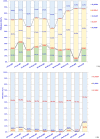Estimated Daily Intake and Cumulative Risk Assessment of Phthalates in the General Taiwanese after the 2011 DEHP Food Scandal
- PMID: 28327585
- PMCID: PMC5361203
- DOI: 10.1038/srep45009
Estimated Daily Intake and Cumulative Risk Assessment of Phthalates in the General Taiwanese after the 2011 DEHP Food Scandal
Abstract
A food scandal occurred in Taiwan in 2011 because the DEHP (di-2-ethylhexyl phthalate) had been intentionally used in food products. We assessed the daily intakes (DIs) and cumulative risk of phthalates in Taiwan's general population after the scandal. The DIs of 6 phthalates, including di-n-butyl phthalate (DnBP), di-iso-butyl phthalate (DiBP), and DEHP, were evaluated using urinary phthalate metabolites. Hazard quotients of phthalates classified as affecting the reproductive (HQrep) and hepatic (HQhep) systems were assessed using cumulative approach. The creatinine-based model showed that the highest DI values in children 7-to 12- years-old were for DEHP (males: median: 4.79 μg/kg bw/d; females: median: 2.62 μg/kg bw/d). The 95th percentile (P95) of HQrep values were all >1 in the 7- to 12-year-old and 18- to 40-year-old male groups. The P95 of HQhep values were all >1 in the 7- to 18- year-old male groups. Most of the HQrep was attributable to the HQs of DnBP and DiBP (53.9-84.7%), and DEHP contributed most to HQhep (83.1-98.6%), which reveals that DnBP, DiBP and DEHP were the main risk of phthalate exposure for Taiwanese. Taiwan's general population is widely exposed to DnBP, DiBP and DEHP, especially for young children.
Conflict of interest statement
The authors declare no competing financial interests.
Figures





Similar articles
-
Internal phthalate exposure over the last two decades--a retrospective human biomonitoring study.Int J Hyg Environ Health. 2007 May;210(3-4):319-33. doi: 10.1016/j.ijheh.2007.01.037. Epub 2007 Mar 30. Int J Hyg Environ Health. 2007. PMID: 17400024
-
Estimated daily intake and cumulative risk assessment of phthalate diesters in a Belgian general population.Toxicol Lett. 2014 Dec 1;231(2):161-8. doi: 10.1016/j.toxlet.2014.06.028. Epub 2014 Jun 23. Toxicol Lett. 2014. PMID: 24968065
-
Phthalates and their metabolites in breast milk--results from the Bavarian Monitoring of Breast Milk (BAMBI).Environ Int. 2011 May;37(4):715-22. doi: 10.1016/j.envint.2011.02.008. Environ Int. 2011. PMID: 21406311
-
Phthalates: metabolism and exposure.Int J Androl. 2008 Apr;31(2):131-8. doi: 10.1111/j.1365-2605.2007.00837.x. Epub 2007 Dec 7. Int J Androl. 2008. PMID: 18070048 Review.
-
Toxicologically relevant phthalates in food.Exp Suppl. 2012;101:87-106. doi: 10.1007/978-3-7643-8340-4_4. Exp Suppl. 2012. PMID: 22945567 Review.
Cited by
-
Perinatal DEHP exposure induces sex- and tissue-specific DNA methylation changes in both juvenile and adult mice.Environ Epigenet. 2021 May 10;7(1):dvab004. doi: 10.1093/eep/dvab004. eCollection 2021. Environ Epigenet. 2021. PMID: 33986952 Free PMC article.
-
Levels of Phthalates, Bisphenol-A, Nonylphenol, and Microplastics in Fish in the Estuaries of Northern Taiwan and the Impact on Human Health.Toxics. 2021 Oct 1;9(10):246. doi: 10.3390/toxics9100246. Toxics. 2021. PMID: 34678942 Free PMC article.
-
Developmental exposures to common environmental contaminants, DEHP and lead, alter adult brain and blood hydroxymethylation in mice.Front Cell Dev Biol. 2023 Jun 13;11:1198148. doi: 10.3389/fcell.2023.1198148. eCollection 2023. Front Cell Dev Biol. 2023. PMID: 37384255 Free PMC article.
-
Impact of Plasticizer on the Intestinal Epithelial Integrity and Tissue-Repairing Ability within Cells in the Proximity of the Human Gut Microbiome.Int J Environ Res Public Health. 2023 Jan 25;20(3):2152. doi: 10.3390/ijerph20032152. Int J Environ Res Public Health. 2023. PMID: 36767519 Free PMC article.
-
Exposure Characteristics and Cumulative Risk Assessment for Phthalates in Children Living near a Petrochemical Complex.Toxics. 2023 Jan 6;11(1):57. doi: 10.3390/toxics11010057. Toxics. 2023. PMID: 36668784 Free PMC article.
References
-
- Wittassek M., Koch H. M., Angerer J. & Bruning T. Assessing exposure to phthalates - The human biomonitoring approach. Mol Nutr Food Res 55, 7–31 (2011). - PubMed
-
- Schettler T. Human exposure to phthalates via consumer products. Int J Androl 29, 134–139 (2006). - PubMed
-
- Gong M. Y., Zhang Y. P. & Weschler C. J. Measurement of Phthalates in Skin Wipes: Estimating Exposure from Dermal Absorption. Environ Sci Technol 48, 7428–7435 (2014). - PubMed
Publication types
MeSH terms
Substances
LinkOut - more resources
Full Text Sources
Other Literature Sources
Medical
Research Materials
Miscellaneous

